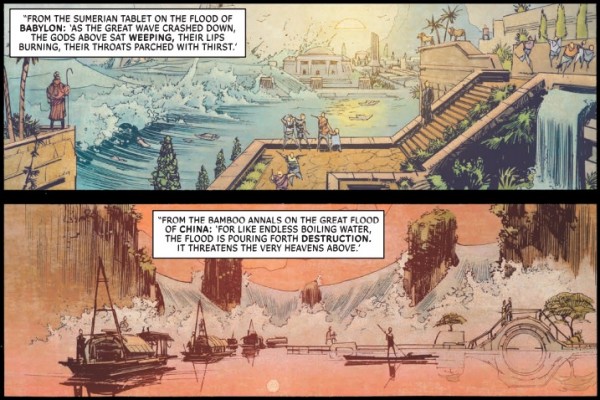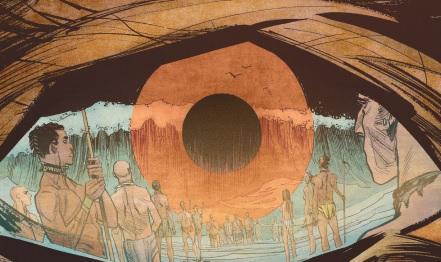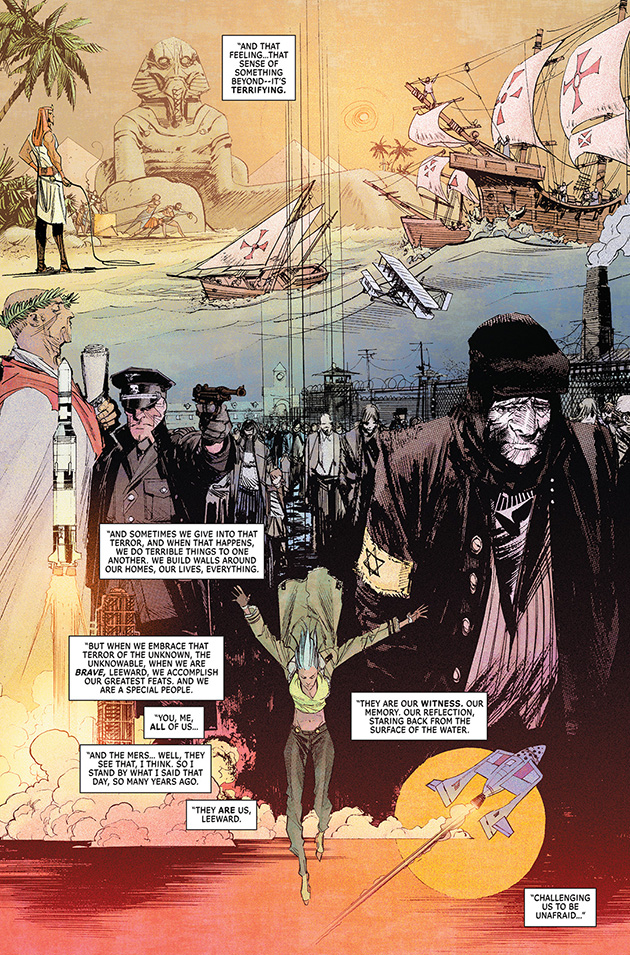Written by Scott Snyder, with art by Sean Murphy and vibrant colors courtesy of Matt Hollingsworth, The Wake starts out as an action/horror adventure before quickly shifting into a high-concept sci-fi epic, two different stories playing with memory and myth, that eventually coalesce into one narrative. Revelations in the tenth and final issue transform The Wake, again, this time into a meditation on remembrance, history, and what makes us human.
SPOILERS AHEAD.
The first half of The Wake focuses on Dr. Lee Archer and other specialists called in to study a mermaid-like creature, and the Alien-esque story that unfolds when the creature escapes. Dark and claustrophobic, mostly taking place on an oil rig at the bottom of the ocean, this half of the story is peppered with time jumps and glimpses into the secret of where the creature came from. The second half of The Wake fast-forwards 200 years to the post-apocalypse, where the Mers (as the creatures are now called) have flooded most of the world and decimated the human population. Here we follow a young woman named Leeward as she tries to find coordinates left behind by Lee Archer, all while evading an authoritarian government and other enemies.
When Leeward finally reaches the coordinates, she finds Lee alive, along with countless others, on board a spaceship at the bottom of the ocean. In the final issue, Lee explains the secret history of humanity to Leeward: humans didn’t come from Earth; we came from a race of people who colonize other planets, wiping out life one step below them on the evolutionary ladder and taking their place. These people are designed to forget their origins; a chemical in tears makes it impossible to remember. But this time something changed. After killing off Earth’s Neanderthal population, the people discovered there was a second species—the Mers. Rather than commit another genocide, the people realized that what they were doing was wrong and that they shouldn’t forget where they came from. “…we did our best to alter the process[…],” Lee explains, “In the end, though, the design was too strong.” The people forgot, but something stayed behind, something that made their descendants restless. And for thousands of years the Mers brought people to the ship so someone would remember.
“They are our witness,” Lee says, “Our memory. Our reflection, staring back from the surface of the water.” Memory is essential to understanding The Wake. The plot and the solution to the conflicts in the story are explicitly tied to memory, and memory as a theme is constant throughout the ten issues. As individuals, we all have memories that are unique to ourselves, and as a race the ability to create, recall, and share memories is what makes humanity unique. Memory is a quintessentially human trait, and it’s used in this story to make the idea of humanity more familiar, changing it from an anonymous mass into a tangible family. The Wake plays with memory, using this personal connection we’ve all experienced in order to guide us to conclusions that are complicated and impersonal.
The Wake incorporates memory even into its most basic level: the structure of the narrative. The very first page is set in our far future, but this isn’t accompanied by a time stamp. In fact, we don’t get a time stamp until later, when we’re introduced to Lee Archer in our present. The time stamp doesn’t read “2014,” however, but “200 Years Earlier.” Snyder and Murphy don’t want the reader to think of 2014 as the story’s present, because it isn’t, it’s the past. The present in the story is Leeward’s time. That flash forward at the beginning? Not a flash forward at all, but a moment to ground us in the reality of the story. It’s there to tell us that Lee’s story is a flashback, it’s a memory of what the world used to be.
Not only is the story structured as recounting a memory, but that’s literally what these first five issues do: they contain the history of humanity Lee tells Leeward about in issue ten. In “The Plains” we watch as early humans wipe out Neanderthals, the topmost rung of Earth’s existing evolutionary ladder. In “The Storyteller,” we experience firsthand the scientist keeping a record through cave paintings of humanity’s arrival on the planet, the subsequent genocide of the people already there, the discovery of the Mers, and the attempts by ancient humans to remember their origins. These flashbacks stop in the second half of the story, once we’re in the present day with Leeward. All flashbacks here are memories that are personally connected to the characters or are linked to the immediate story: Leeward’s family’s failed escape from The Arm, for example, and the three months that pass between Leeward getting picked up by Captain Mary’s crew and when they reach the coordinates.
The narrative reminds us over and over that memory is important, but the telling of legends throughout the series is a way to show that memory is not infallible. Legends are a reminder that memory can corrode and change as time passes from the initial event, another theme important to the climax of this story. The act of telling a legend is an act of remembering, and though legends aren’t entirely accurate in their retelling, they still symbolize a record of a culture now gone. Legends are recounted often in the first half of The Wake, usually by Dr. Marin, a professor of folklore and mythology who is hired to study the Mer alongside Lee.
Dr. Marin introduces us to the idea of a “raindrop.” “It’s a term in folklore studies,” he explains, “It means the real-life referent that inspires a system of folklore. The raindrop hits the water, and concentric rings of lore spread from the point of impact.” Dr. Marin goes on to explain that the Mers could be inspiration for mermaid mythology. Snyder and Murphy use our understanding of raindrops to introduce a red herring into the story in the second half of The Wake. Often referenced by Leeward, the Golden Net is the legend of how a literal net at the bottom of the ocean will one day gather up all the Mers and make the ocean safe again.

Dr. Marin posits that a real-life “raindrop” led to legends of great floods across the globe. (The Wake #5)
The raindrop that inspires the legend of the Golden Net is an important part of the plot of the first book, referred to by Lee and others as S-Net, a sonic weapon that is deadly to sea animals. The S-Net is what informs Lee’s escape plan from the drill: “Now S-Net, a sonic defense project that the Navy was working on, it created a sound almost as loud as a sonic boom, about 200 decibels. Now that’s enough to make whales’ ears bleed. We run the drill hot, I’ll bet we can get her up to what, Mel? 180? 190?” And later: “I’m saying we run that drill to max capacity and shake those creatures’ heads apart.” It follows logically that the coordinates Leeward finds are for the controls of the S-Net and all she has to do is turn it on in order for this story to conclude. Having read the book (or just this essay) we already know that isn’t what happens, but on a second read-through it becomes clear that this legend is never going to be the real solution to the story’s conflict. The authors have been leaving us breadcrumbs to the real solution the whole time.
It’s all about the eyes. Eyes are often used as motif in fiction. Ever hear that “eyes are the windows into the soul” or about a character having a third eye? The Wake takes that expectation of eyes being figuratively important and raises it, making eyes literally essential to the plot. As Lee says: “…the key was in the tears, Leeward. A chemical beneath the lipocalin and lysozyme and the proteins there today. A substance that destroyed pkmzeta molecules, disabled and erased memory. Within a generation, two at most, the story of our arrival would be lost to us.” On a first read-through, eye imagery blends into the background. In a second read through, it’s more obvious that eye imagery is being used to forecast the ending revelation.
Eyes are often highlighted in the art, either becoming the focus of a panel or being used to telegraph emotional beats, but they’re also used to keep the theme of memory threaded through the story. In the flashback at the end of issue one, known as “The Storyteller,” a man is holed up in a cave and blinds himself with a futuristic tool. His blood splatters the cave wall, and his paintings of the Mer, the sun, and one eye, a single tear dripping from it. In the second issue, when Lee is hiding a memory from the rest of the oil rig crew, she’s depicted with eyes cast in shadow. On the very next page, in the very next panel, her eye is the focus as we slip into that memory, visually connecting eyes with recollection of memory. Mers shoot venom into people’s eyes, causing hallucinations. The Mers’ eyes themselves are distinct: completely circular, with large and dark pupils, like sharks’ eyes. The title page in issue five is a close up of a tearful eye, a giant tidal wave reflected in it. Also in issue five: we learn Lee has a tear deficiency, meaning she has a hard time producing her own tears. Leeward shares this problem, as we see her using the same eye drops Lee uses. Of course they’re the story’s heroes, they literally can’t produce tears, they lack the chemical that caused the forgetting in the first place. Lee and Leeward can symbolically and literally remember what everyone else has forgotten.
In issue ten there’s a line that echoes all the way back to a moment in the first issue, when Lee comes face to face with a Mer for the first time. This page is almost entirely filled with a silhouette of Lee, lit up by the Mer in its tank, and at the bottom of the page are two inset panels. In one is a close-up of Lee’s face, her eye the only part in its entirety, and in the other panel is the Mer’s face, mirroring Lee’s, its own eye flat and fish-like and full of hate. In issue ten, Lee says: “…our eyes might be designed to make us forget…but theirs are designed to make us remember.” The first meeting between Lee and the Mer foreshadows this moment: Lee is the one who remembers humanity’s start, and this information is given to her because of the Mers. Because Lee is able to remember, she’s able to relay humanity’s history to Leeward, and Leeward is able to change the way humanity perceives the Mers. That page in the first issue shows us Lee looking into the Mer’s eyes, foreshadowing how the Mers help her to remember, and the revelation that the Mers are the keepers of memory for the entire human race.
This ending elevates The Wake into the realm of really good sci-fi. It refuses to rely on the easiest solution, rejecting the legend of the Golden Net, an ending that would have led to a slaughter, and instead opts for a creation myth, turning the whole of the story into a legend all its own. This ending isn’t perfect. In fact, it leaves several important questions unanswered, but the way the story leads us to and prepares us for this conclusion isn’t flawed. There’s an art to the way the imagery and themes are threaded throughout the narrative, slowly building to an ending that’s believable because of the risks the story takes and the work put into it. The Wake could have just been a story about how mermaids are real and terrifying, but instead it becomes an introspective of what makes us human, and why we explore, and why we hurt each other.
The Wake #10 is in comics stores now, and a hardcover collection of the series is expected in November.



